How to clean grout in tiles – foolproof methods to get grout squeaky clean
Transform your grout from grubby to gleaming with our expert cleaning tips

- 1. How to clean grout with a steamer
- 2. How to clean grout with no chemicals
- 3. How to clean grout with whitening toothpaste
- 4. How to clean grout with white vinegar
- 5. How to clean grout with bicarbonate soda and vinegar
- 6. How to clean grout with lemon juice
- 7. How to clean grout with bleach
- How to clean grout in a shower
- How to prevent mould and mildew buildup on grout
- FAQs

Knowing how to clean grout is one of the best ways to keep your bathroom looking clean and tidy, especially if you’ve spotted the tell-tale signs of mould and mildew.
After all, if you’ve brought your dream bathroom tile ideas to life or spent a fortune on shower tiles, the last thing you want to see is them ruined by dirt, grime, and slimy substances. But unfortunately, these small spaces are a breeding ground for bacteria and mildew.
'If you don’t clean your bathroom tiles regularly, you may soon notice residues from soap and shampoo in your shower, once-white grout turning black, and grime appearing in cracks and corners,' says Sue Caldwell, Managing Director, Clean Living International.
Thankfully, you don’t have to rip out your bathroom or learn how to grout tiles to banish this build-up of grime. We’ve spoken to the experts and come up with seven handy ways to clean grout in tiles, even if you think they’re past the point of no return.
How to clean grout in tiles
'Whilst cleaning your grout might not seem like the most fascinating job, don’t skip it,' says Harriet Goodacre, Tile Consultant, Topps Tiles. 'As grout is a porous substance, if not properly cared for it can attract mould and mildew, which can build up and stain if not dealt with properly.' So, this is how you can clean grout in tiles.

We recommend trying these methods in the order that they are listed, as they get progressively more aggressive. Lighter stains can be tackled with the first few methods, which are gentler, but for mould and mildew, you'll probably have to try the techniques we list later on.
1. How to clean grout with a steamer

What you'll need
- Steam cleaner with small brush attachment - browse the steam cleaners available at Amazon
- Warm water
If you've already got one of the best steam cleaners, then you're in luck because these devices work wonders on grout. The hot temperature of the steam will lift the dirt and grime out of your grout lines, leaving them fresh and clean once you've finished.
- Fill your steam cleaner with water then attach a small brush - ideally a round one.
- Run the steamer along the grout lines, applying a gentle scrubbing motion as you go.
- Marks should start to lift. Repeat if necessary.
2. How to clean grout with no chemicals
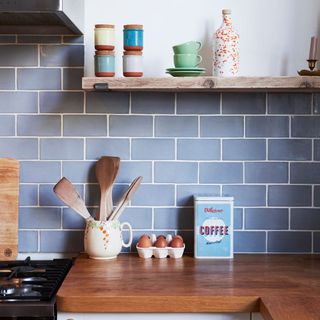
What you'll need
- A scrubbing brush or old electric toothbrush - browse through Amazon's selection of scrubbing brushes
- Warm water
Sometimes, learning how to clean grout in tiles can be as easy as giving it a good scrub. You can buy special scrubbing brushes, such as the Sonic Scrubber Cleaning Tool, £18.99 at Lakeland. The interchangeable heads will fit between the tiles easily and oscillate at 10,000 times a minute. With a tool like this, you might find a little warm water is all you need to get your grout looking as good as new.
How to
- Using a scrubbing brush, or an old electric toothbrush, scrub the grout with warm water in a circular motion. If the stains are fairly new and they haven't had chance to really settle yet, this method should help them to lift away.
3. How to clean grout with whitening toothpaste

What you'll need
- Scrubbing brush or old electric toothbrush
- Whitening toothpaste - stock up on powerful whitening toothpaste at Amazon
The clue's in the name; whitening toothpaste can help whiten your grout as well as your teeth. That's because it contains bicarbonate of soda, which is a powerful ingredient that can lift stains.
How to
- Apply bicarbonate of soda to the grout using a scrubbing brush or an old toothbrush.
- Rinse away with warm water and pat dry with a clean towel. The toothpaste should act as a mild abrasive that will help remove any black tinges.
4. How to clean grout with white vinegar
What you'll need
- Scrubbing brush
- White vinegar - stock up on white vinegar at Amazon
- Spray bottle - there's plenty of spray bottles available at Amazon
- Warm water
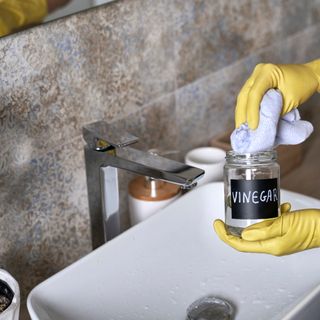
'White vinegar is well-known for being one of the most versatile and effective natural cleaners available,' says Sarah Dempsey, Cleaning Expert, MyJobQuote. 'It is naturally acidic, meaning that it can prevent the growth of mould, mildew, and other types of bacteria.'
Cleaning with vinegar is a tried and tested method for many areas in the home, especially when it comes to mould. Aside from being an effective method for removing mould and mildew from outdoor cushions, it can be used to get your grout white again.
How to
- Fill a spray bottle with half vinegar and half warm water. Spray it onto the grout, and leave it to stand for five minutes before giving a good scrub with a stiff brush.
- A regular spritz of vinegar spray is a great way to keep your grout in tip-top condition in between deep cleans and can help prevent mould build-up over time.
5. How to clean grout with bicarbonate soda and vinegar
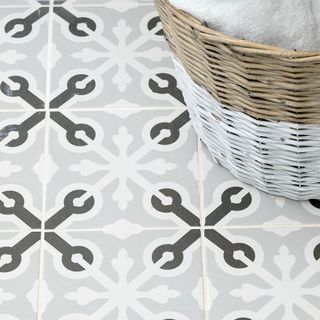
What you'll need
- Scrubbing brush or old toothbrush
- Bicarbonate of soda - buy bicarb of soda in bulk at Amazon
- White vinegar
'Baking soda and white distilled vinegar are two of nature’s greatest natural cleaners, and they work wonders on removing stubborn stains on all kinds of surfaces', says Sue from Clean Living International.
Mixing together these two store cupboard essentials will work wonders on your grout. Follow the steps below for best results.
How to
- Mix together a thick paste of bicarbonate of soda and white vinegar
- Once it's fizzed, apply the paste to the grout with a small brush or an old toothbrush. Leave for 15 minutes.
- Rinse away and your grout should come up looking clean and fresh.
6. How to clean grout with lemon juice
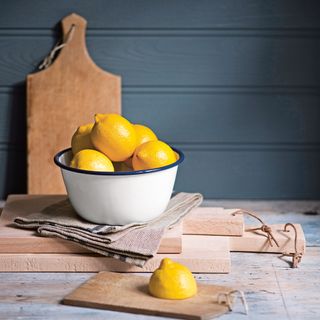
What you'll need
- Fresh lemon - stock up on lemons at Ocado
- Toothbrush
The natural acidity in lemons make them a great cleaning agent, and it will work especially well if your grout is suffering from discolouration or stains. You might already have a lemon knocking around your fridge, but if not, they're nice and cheap at the supermarket.
How to
- Slice a fresh lemon in half, and run the juice along the grout.
- Leave on for at least 15 minutes, then give it a scrub with a clean toothbrush.
- Rinse away with warm water and pat dry with a clean towel.
7. How to clean grout with bleach

What you'll need
- Toothbrush
- Bleach - there's plenty of bleach options at Amazon
- Bicarbonate of soda
'Bleach is best when it comes to removing that top layer of stubborn mould and grime from grout,' says Rachael Meadowcroft, Product Manager, Ronseal.
You should reserve using bleach for those stubborn grout stains that you can't seem to budge, as it can fade the colour of your grout if used in excess. Before you set to work, make sure you have opened any windows or doors to keep the space well-ventilated.
There are two ways to use bleach when learning how to clean grout in tiles. You can use it neat, pouring a small amount into a cup and dipping an old toothbrush into it before scrubbing. Alternatively, you can follow the steps below, which is our preferred method.
How to
- Make a paste out of bleach and bicarbonate of soda until it resembles toothpaste consistency.
- Apply it to the grout and leave for 15 minutes, then take an old brush and scrub the paste away.
- 'Be sure to rinse the tiles after and avoid using any paper or cloth-based products to wipe as this will leave fibres on your freshly cleaned surface’, advises Rachael.
- Allow the grout to air dry.
How to clean grout in a shower
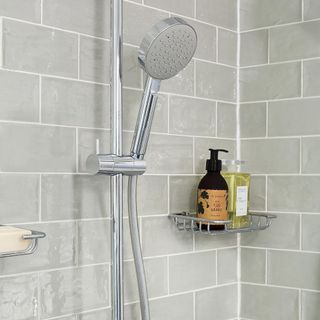
What you'll need
- Choose a solution from above
- Cotton wool bud
'In most households, showers are used multiple times a day, so grime can quickly build up, with a film of soap scum forming, mould appearing along seals and once-white grout turning black,' says Sue Caldwell.
Grout that's turned yellow - or even worse, black - is a sure way to ruin the look of any shower ideas. Knowing how to clean grout in tiles in the shower is tricky, thanks to tight corners.
To make sure you get in each and every corner, when applying your toothpaste, vinegar, lemon, or bleach, swap the toothbrush for a cotton wool bud. Cotton buds are great for cleaning small crevices, so you can ensure even the bottom corners of your shower are sparkling.
Now you know how to clean grout in tiles, which method will you be using to get your grout looking as good as new?
How to prevent mould and mildew buildup on grout
There’s no point in spending hours cleaning the grout in your bathroom or kitchen if you don’t know how to prevent this mould and mildew from returning. In a few months, you’ll be repeating the above methods once more in an effort to clean them again.
Thankfully, there are some steps you can take to prevent this mould and mildew buildup on grout, as explained below:
Clean regularly: If you clean your bathroom or kitchen on a regular basis but still get dirty grout, it may be that you’re not cleaning it in the right places. It’s important to clean the areas of your house that see the most moisture - including any corners. Give these areas some extra TLC, using anti-mould cleaners or natural cleaners such as vinegar or tea tree oil.
Use a dehumidifier: Ultimately, mould and mildew buildup on your grout is caused by excess moisture in your bathroom or kitchen. And while it may seem impossible to control moisture in a room that’s home to baths, showers, sinks, and hobs, there are several ways to do this. You could keep your extractor fan on for longer, you could keep your windows open, or you could use one of the best dehumidifiers. Using this for just a few hours a day can make a real difference.
Dry tiles after showering: There’s a high chance that you already use a squeegee to dry your shower screen after showering, but next time you have a wash, take a few extra seconds to use the same squeegee on the walls. By removing this excess water from the tiles, you can dry them off and reduce the chances of mould and mildew growing. You can also do the same in your kitchen if you notice a build-up of moisture on the tiles.
FAQs
How can I get my grout white again?
To uncover your grout's original whiteness, you need to remove the layer of mould, mildew and dirt that is covering it. Depending on how thick this layer is, you can clean it using milder agents like whitening toothpaste, white vinegar spray or just warm water, but if the black is proving more stubborn, you may have to use bleach.
Old toothbrushes are perfect for cleaning grout because their bristles can scrub the grout lines without damaging the tiles. After you've given your grout a good clean using your chosen detergent, try using lemon juice to break down any remaining stains or discolouration.
'Using fresh lemon juice is always a good shout for removing stains, especially in porous grout, due to its acidity and ability to break down stubborn stains,' suggests James Roberts, Director, Sanctuary Bathrooms.
Is bleach bad for grout?
'Bleach is great for deep cleaning grout but using it too frequently can eventually weaken the grout and make it crumble,' says Laura Mountford, Cleaning Influencer. 'I tend to only use it if my grout it is particularly bad and be sure to rinse properly. Never mix bleach with other chemicals and be sure that the room is well-ventilated.'
So although you can use household bleach to clean grout, don't resort to this in the first instance. Try other methods like white vinegar, bicarbonate of soda and lemon first, then use bleach if the mould and mildew isn't budging. Using it sparingly shouldn't cause any real damage.
What is the best homemade tile grout cleaner?
A lot of professionals will advise that you can learn how to clean grout in tiles well enough with household items you likely already have in your store cupboard.
'To successfully remove the dirt from your grout, one of the oldest tricks in the book is to apply bicarbonate of soda, water and vinegar, and scrub with a clean toothbrush,' says Christopher Nye, Cleaning Expert, Your Overseas Home. 'This method costs pennies but could make it look like it has been freshly regrouted.'
Bathroom expert James Roberts agrees. 'White vinegar, baking soda, and hydrogen peroxide are all effective cleaning agents for cleaning mould from grout as they are mild abrasives,' he explains.
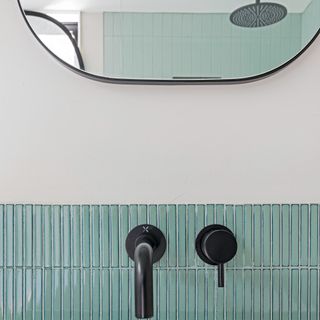
How to clean grout between floor tiles?
'For floor tiles, cleaning products or degreasing agents that contain wax, sodium silicate or other additives that leave sticky deposits should be avoided as these will create a dirt “key” on the floor,' advises David Talbot, Head of Specification, Craven Dunnill Jackfield.
Your floor tiles and grout can easily be kept clean with regular brushing and then mopping using warm water to which a neutral or nearly neutral sulphate detergent is added. Leave the solution on the floor for a period of 5 to 15 minutes, depending on how dirty the grout is. Then remove the solution with a mop and clean water.
'It is this “rinsing” operation that removes the dirt so the use of clean water is essential,' explains David.
With a little elbow grease and the right cleaning formula, you'll have your grout looking like new in no time.
So, it's time to get cleaning!
Get the Ideal Home Newsletter
Sign up to our newsletter for style and decor inspiration, house makeovers, project advice and more.

Rebecca Knight has been the Deputy Editor on the Ideal Home Website since 2022. She graduated with a Masters degree in magazine journalism from City, University of London in 2018, before starting her journalism career as a staff writer on women's weekly magazines. She fell into the world of homes and interiors after joining the Ideal Home website team in 2019 as a Digital Writer. In 2020 she moved into position of Homes News Editor working across Homes & Gardens, LivingEtc, Real Homes, Gardeningetc and Ideal Home covering everything from the latest viral cleaning hack to the next big interior trend.
- Katie SimsContributor
- Lauren BradburyContributor
-
 Is Habitat the new Zara Home? The affordable quiet luxury alternatives to snap up fast
Is Habitat the new Zara Home? The affordable quiet luxury alternatives to snap up fastHabitat is the new budget-friendly alternative for Zara Home – as lookalike quiet luxury homewares sell for less
By Sara Hesikova
-
 I tested Brabantia's Wallfix outdoor airer – it's a genius space-saver for drying laundry in a small garden
I tested Brabantia's Wallfix outdoor airer – it's a genius space-saver for drying laundry in a small gardenOur Brabantia Wallfix Dryer review puts this space-saving outdoor airer to the test to see if it's the ideal laundry solution for small outdoor spaces. *Spoiler alert* we think it just might be.
By Amy Lockwood
-
 The 7 best fast-growing hedges to ramp up your garden's privacy
The 7 best fast-growing hedges to ramp up your garden's privacyHoping to grow a privacy hedge as quickly as possible? Look this way...
By Kayleigh Dray